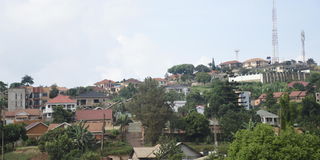Fall in land prices sparks fear of default on real estate loans

Bank of Uganda has reported a decline in assets quality, which presents banks with the risk of default on real estate loans. PHOTO | EDGAR R. BATTE
Assets quality in the real estate sector for the first time since 2007/08 declined in value in the half year ended June 2020, according to Bank of Uganda.
The decline, according to the Bank of Uganda Financial Stability Review June 2020, presents “risks to credit performance arising from the real estate sector, which is experiencing a decline in the price of residential properties and land.
For instance, the report indicates, during the period, the threat was most exhibited in a decline in the prices of residential property, which fell by 2.9 per in the first half of 2020.
The decline presents a risk in timely loan servicing, especially in the real estate sector, which according to Uganda Bankers Association currently holds the biggest share of restructured loans.
Speaking during the fourth Economic Growth Forum in Kampala last month, Mr Wilbrod Owor, the UBA executive director, said 50 per cent of the loans restructured in April, May and June were in real estate and trade.
This means that the two sectors hold at least Shs2.95 trillion of the Shs5.9 trillion consolidated loan amounts that were restructured in the three months to June.
Mr Owor also noted that the banking sector had conducted stress tests, which indicated the likelihood of non-performing loans increasing to 7.2 per cent (Shs1.2 trillion) by end of September or 9.1 per cent (Shs1.33 trillion) by end of December.
Real estate most stressed
The tests, he said, had returned small and medium enterprises and real estate as the most stressed sectors with a high default risk on existing loans.
However, Mr Owor did not reveal of distress in specific sectors.
In its report, Bank of Uganda indicated that “asset quality, as measured by the ratio of nonperforming loans to total loans [had] worsened across the banking sector through the year ended June 2020.
During the period, Bank of Uganda said, the ratio of non-performing loans had increased from 3.8 per cent in June 2019 to 5.8 per cent in June 2020.
The increase was blamed on deterioration largely coming from real estate, trade and commerce, and household sectors.
However, Ms Judy Rugasira, the Knight Frank managing director, told Daily Monitor yesterday the 2.9 per cent decline in property prices was such a negligible figure to have a big impact on non-performing loans.
“I am not sure how they arrived at that conclusion because there were very few, if any property transactions, in the first half of 2020. The Lands Registry was closed until June. So am not sure how or where those sales were registered. Similarly a 2.9 per cent sale is negligible and shouldn’t really have that big an impact on non-performing loans,” she said.
The Central Bank has also forecasted that: “Asset quality is likely to deteriorate further in the near term, if maturing credit relief is still distressed, as well as on account of a slow recovery in economic activity”.
Some of the loans that had benefited from a three or four month repayment holiday have matured or nearing maturity yet some of them, according to UBA, are still facing distress.
However, the Central Bank indicated that it had put in place measures, especially in support of the real estate sector to shield a further deterioration.
For instance, the impact of falling property prices on banking institutions’ collateral values had been “alleviated by prudent loan-to-value ratios maintained by supervised financial institutions, which remained below the limit of 85 per cent on residential mortgages and land purchase loans while the ratio on foreign currency loans for land purchase remained above 90 per cent during the period.
The real estate sector continues to record some distress given the number of property disputes currently in the banking sector, arising from default on loan facilities advanced in the last two years.
However, Covid-19-related disruptions have created more distress and there is a likelihood of an increase in property disputes going forward.
“Looking ahead, asset quality is likely to deteriorate further in the near term,” the Central Bank said, noting it had maintained the 85 per cent limit on loan-to-value ratio of loans for residential mortgages and land purchase, effective June 1 to mitigate risks to asset quality and valuation associated with falling property prices.
Mitigation measures
Going forward, Bank of Uganda says, it will maintain measures earlier implemented to alleviate shocks to financial
stability. These include:
*Exceptional permission to supervised financial institutions to provide credit relief to borrowers affected by Covid-19, for 12 months effective April 1, 2020.
*Exceptional liquidity assistance facility for supervised financial institutions that have or may come under liquidity distress.
* A limit of 85 percent on the loan-to-value ratio of loans for residential mortgages and land purchase, effective June 1, 2020 to mitigated risks to asset quality and valuation.




